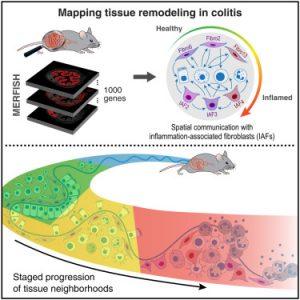The intestines perform a complex ballet of functions, from absorbing nutrients to maintaining a healthy internal environment. Chronic disorders like inflammatory bowel disease (IBD) disrupt this delicate balance, triggering gut inflammation and remodelling the gut’s cellular landscape. To gain a deeper understanding of these changes, researchers have employed a powerful new tool: MERFISH (multiplexed-error robust-fluorescence in situ hybridization) (Figure 1).
This innovative technique allows researchers to analyse a staggering number of genes within individual intestinal cells. In a mouse model of colitis, the researchers used MERFISH to analyse a whopping 940 genes in a massive dataset of 1.35 million intestinal cells. This comprehensive analysis provided a detailed picture of the cell populations present in both healthy and inflamed states, revealing their spatial distribution and how these populations shift during the inflammatory process.
One particularly interesting finding centered on fibroblasts, a type of structural cell within the gut. The study revealed that under stressed conditions, fibroblasts can transform into “inflammation associated fibroblasts” (IAFs). These IAFs play a complex role, potentially remodeling the gut’s structural elements (the extracellular matrix), recruiting immune cells, and even producing inflammatory molecules called cytokines.
While the identification of IAFs is a significant step forward, some key questions remain. Researchers are still working to understand the specific diversity of IAF populations, their precise locations within the gut tissue, and the exact mechanisms by which they arise during inflammation.
Despite these remaining questions, the study has successfully generated a unique “spatial atlas” of the mouse colon, detailing both healthy and inflamed states. This detailed map holds tremendous potential for researchers developing new therapeutic approaches for chronic inflammatory bowel diseases. By understanding the cellular players and their interactions within the inflamed gut, researchers can develop more targeted treatments to combat these debilitating conditions.
Journal article: Cadinu, P., et al. 2024. Charting the cellular biogeography in colitis reveals fibroblast trajectories and coordinated spatial remodeling. Cell.
Summary Stefan Botha











